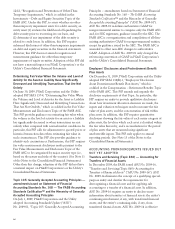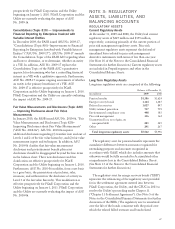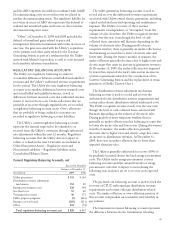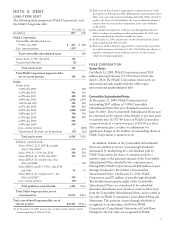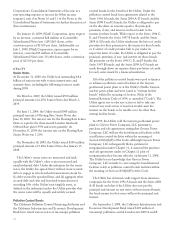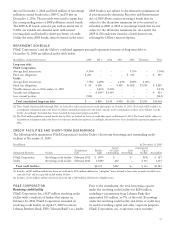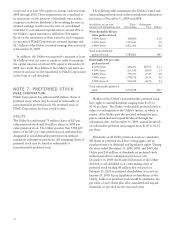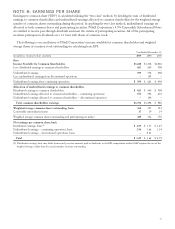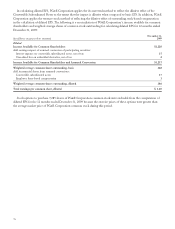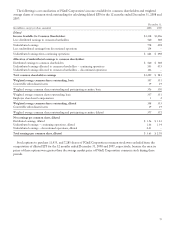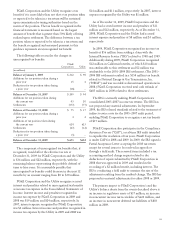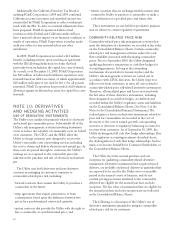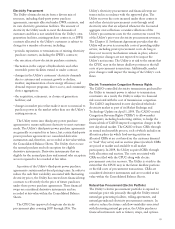PG&E 2009 Annual Report Download - page 78
Download and view the complete annual report
Please find page 78 of the 2009 PG&E annual report below. You can navigate through the pages in the report by either clicking on the pages listed below, or by using the keyword search tool below to find specific information within the annual report.outstanding in whole or in part. At PG&E Corporation’s
request and at the sole discretion of each lender, the
revolving credit facility may be extended for additional
periods. PG&E Corporation has the right to increase, in
one or more requests given no more than once a year, the
aggregate facility by up to $100 million provided that
certain conditions are met. The fees and interest rates that
PG&E Corporation pays under the revolving credit facility
vary depending on the Utility’s unsecured debt ratings
issued by Standard & Poor’s (“S&P”) ratings service and
Moody’s Investors Service (“Moody’s”).
The revolving credit facility includes usual and
customary covenants for credit facilities of this type,
including covenants limiting liens, mergers, sales of all or
substantially all of PG&E Corporation’s assets, and other
fundamental changes. In general, the covenants,
representations, and events of default mirror those in the
Utility’s revolving credit facility, discussed below. In
addition, the revolving credit facility also requires that
PG&E Corporation maintain a ratio of total consolidated
debt to total consolidated capitalization of at most 65%
and that PG&E Corporation own, directly or indirectly, at
least 80% of the common stock and at least 70% of the
voting securities of the Utility. At December 31, 2009,
PG&E Corporation met both of these tests.
UTILITY
Revolving credit facility
The Utility has a $1.94 billion revolving credit facility with
a syndicate of lenders that expires on February 26, 2012.
The Utility amended its revolving credit facility on
April 27, 2009 to remove Lehman Bank as a lender. Prior
to the amendment, the total borrowing capacity under the
revolving credit facility was $2.0 billion, including a
commitment from Lehman Bank that represented $60
million, or 3%, of the total. Borrowings under the
revolving credit facility and letters of credit are used
primarily for liquidity and to provide credit enhancements
to counterparties for natural gas and energy procurement
transactions. The Utility treats the amount of its
outstanding commercial paper as a reduction to the
amount available under its revolving credit facility so that
liquidity from the revolving credit facility is available to
repay outstanding commercial paper.
The revolving credit facility includes usual and
customary covenants for credit facilities of this type,
including covenants limiting liens to those permitted under
the senior notes’ indenture, mergers, sales of all or
substantially all of the Utility’s assets, and other
fundamental changes. In addition, the revolving credit
facility also requires that the Utility maintain a debt to
capitalization ratio of at most 65% as of the end of each
fiscal quarter. At December 31, 2009, the Utility met this
ratio test.
Commercial Paper Program
The Utility has a $1.75 billion commercial paper program, the
borrowings from which are used primarily to cover
fluctuations in cash flow requirements. Liquidity support for
these borrowings is provided by available capacity under the
Utility’s revolving credit facility, as described above. The
commercial paper may have maturities up to 365 days and
ranks equally with the Utility’s other unsubordinated and
unsecured indebtedness. Commercial paper notes are sold at
an interest rate dictated by the market at the time of issuance.
At December 31, 2009, the average yield was 0.31%.
NOTE 5: ENERGY RECOVERY
BONDS
In 2005, PG&E Energy Recovery Funding, LLC (“PERF”), a
wholly owned consolidated subsidiary of the Utility, issued
two separate series of ERBs in the aggregate amount of $2.7
billion to refinance a regulatory asset that the Utility
recorded in connection with the Chapter 11 Settlement
Agreement. The proceeds of the ERBs were used by PERF
to purchase from the Utility the right, known as “recovery
property,” to be paid a specified amount from a dedicated
rate component (“DRC”) to be collected from the Utility’s
electricity customers. DRC charges are authorized by the
CPUC under state legislation and will be paid by the
Utility’s electricity customers until the ERBs are fully
retired. Under the terms of a recovery property servicing
agreement, DRC charges are collected by the Utility and
remitted to PERF for payment of principal, interest, and
miscellaneous expenses associated with the bonds.
The first series of ERBs issued on February 10, 2005
included five classes aggregating to a $1.9 billion principal
amount with scheduled maturities ranging from
September 25, 2006 to December 25, 2012. Interest rates
on the remaining three outstanding classes range from
4.14% for the earliest maturing class to 4.47% for the latest
maturing class. The proceeds of the first series of ERBs
were paid by PERF to the Utility and were used by the
Utility to refinance the remaining unamortized after-tax
balance of the settlement regulatory asset. The second
series of ERBs, issued on November 9, 2005, included
three classes aggregating to an $844 million principal
amount, with scheduled maturities ranging from June 25,
2009 to December 25, 2012. Interest rates on the remaining
two classes are 5.03% for the earliest maturing class and
5.12% for the latest maturing class. The proceeds of the
second series of ERBs were paid by PERF to the Utility to
pre-fund the Utility’s tax liability that will be due as the
Utility collects the DRC charges from customers.
74




